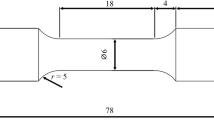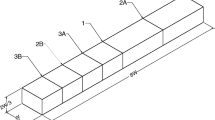Abstract
The combination of various residual stress measurement methods is a common practice to complete knowledge that a single measurement method cannot provide. In this study, incremental X-Ray diffraction is combined with the contour method to measure a bent notched specimen to study the methods robustness. A finite element analysis model is built and validated with strain measurement of the bending process thus providing prior knowledge of the residual stress field. Three-dimensional neutron diffraction residual stress measurements are also performed to obtain a reference measurement with a non-destructive method and to validate the simulated stress field. In-depth stress gradient measured by X-ray diffraction is corrected with four different methods that all show good correlation with neutron diffraction measurements. Correction methods, assumptions and uncertainties are discussed and differences are observed on the robustness of the methods. Contour method measurements are performed and results are also in agreement with neutron measurements. The results provided by the contour method are complementary to those of the X-Ray diffraction since, despite a lower accuracy on the edges where X-ray diffraction is performed, the contour method offers the complete cartography of longitudinal stress in a symmetry plane of the bent specimen. Uncertainty of the contour method due to the post-processing procedure is discussed.




















Similar content being viewed by others
References
McCLUNG RC (2007) A literature survey on the stability and significance of residual stresses during fatigue. Fatigue Fract Eng Mater Struct 30(3):173–205
Withers PJ (2007) Residual stress and its role in failure. Rep Prog Phys 70(12):2211
Schajer GS, Ruud CO (2013) Overview of residual stresses and their measurement. Practical residual stress measurement methods, Schajer GS, Ed. John Wiley & Sons, Ltd 1–27
Perenda J, Trajkovski J, Žerovnik A, Prebil I (2015) Residual stresses after deep rolling of a torsion bar made from high strength steel. J Mater Process Technol 218:89–98
Epp J, Surm H, Hirsch T, Hoffmann F (2011) Residual stress relaxation during heating of bearing rings produced in two different manufacturing chains. J Mater Process Technol 211(4):637–643
Pagliaro P, Prime MB, Robinson JS, Clausen B, Swenson H, Steinzig M, Zuccarello B (2010) Measuring inaccessible residual stresses using multiple methods and superposition. Exp Mech 51(7):1123–1134
Toparli MB, Fitzpatrick ME, Gungor S (2015) Determination of multiple near-surface residual stress components in laser peened aluminum alloy via the contour method. Metall Mater Trans A 46(9):4268–4275
Xie P, Zhao H, Wu B, Gong S (2015) Evaluation of residual stresses relaxation by post weld heat treatment using contour method and x-ray diffraction method. Exp Mech 55(7):1329–1337
Elmesalamy A, Francis JA, Li L (2014) A comparison of residual stresses in multi pass narrow gap laser welds and gas-tungsten arc welds in AISI 316 L stainless steel. Int J Press Vessels Pip 113:49–59
Scholz J (2002) Experimental analysis and modelling of the mechanical behaviour of an unstable austenitic stainless steel, Paris 6
Voce E (1955) A practical strain-hardening function. Metallurgica 51:219–226
Armstrong PJ, Frederick CO, Central Electricity Generating Board (1966) A mathematical representation of the multiaxial Bauschinger effect
Hauk V (1997) Structural and residual stress analysis by nondestructive methods A2 - . structural and residual stress analysis by nondestructive methods, Amsterdam: Elsevier Science B.V., iii
Prévey P (1986) X-ray diffraction residual stress techniques. ASM, 380–392
Moore MG, Evans WP (1958) Mathematical correction for stress in removed layers in x-ray diffraction residual stress analysis, SAE International, Warrendale, PA, SAE Technical Paper 580035
Pedersen TF, Hansson ILH (1989) Finite element calculations for correction of residual stress profiles of coated and uncoated materials measured by X-ray diffraction. NDT Int 22(6):347–352
Lambda Research (1996) Finite element correction for stress relaxation in complex geometries
Savaria V, Bridier F, Bocher P (2012) Computational quantification and correction of the errors induced by layer removal for subsurface residual stress measurements. Int J Mech Sci 64(1):184–195
Murray CE, Cevdet Noyan I (2013) Applied and residual stress determination using x-ray diffraction. Practical residual stress measurement methods, Schajer GS, Ed. John Wiley & Sons, Ltd, 139–161
Savaria V, Monajati H, Bridier F, Bocher P (2015) Measurement and correction of residual stress gradients in aeronautical gears after various induction surface hardening treatments. J Mater Process Technol 220:113–123
Prime MB (2000) Cross-sectional mapping of residual stresses by measuring the surface contour after a cut. J Eng Mater Technol 123(2):162–168
De Wald AT, Prime MB (2013) The contour method. practical residual stress measurement methods. Wiley, West Sussex, pp 109–138
Kjer WJHM (2010) Evaluation of surface registration algorithms for PET motion correction
MATLAB and Statistics Toolbox Release (2012b) The MathWorks, Inc., Natick, Massachusetts, United States. Csaps function, Cubic smoothing spline
Acknowledgments
The financial support of DGA/MRIS (Mission for Scientific Research and Innovation) is gratefully acknowledged. The authors would also like to thank the Laboratoire Léon Brillouin of the CEA Saclay for the beamtime at line G 5-2.
Author information
Authors and Affiliations
Corresponding author
Rights and permissions
About this article
Cite this article
Levieil, B., Bridier, F., Doudard, C. et al. User Influence on Two Complementary Residual Stress Determination Methods: Contour Method and Incremental X-Ray Diffraction. Exp Mech 56, 1641–1652 (2016). https://doi.org/10.1007/s11340-016-0189-3
Received:
Accepted:
Published:
Issue Date:
DOI: https://doi.org/10.1007/s11340-016-0189-3




